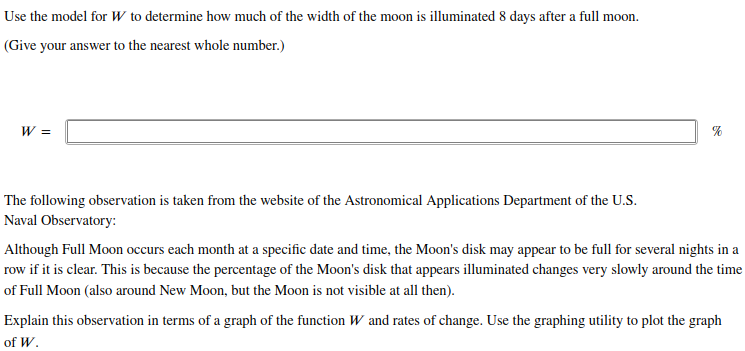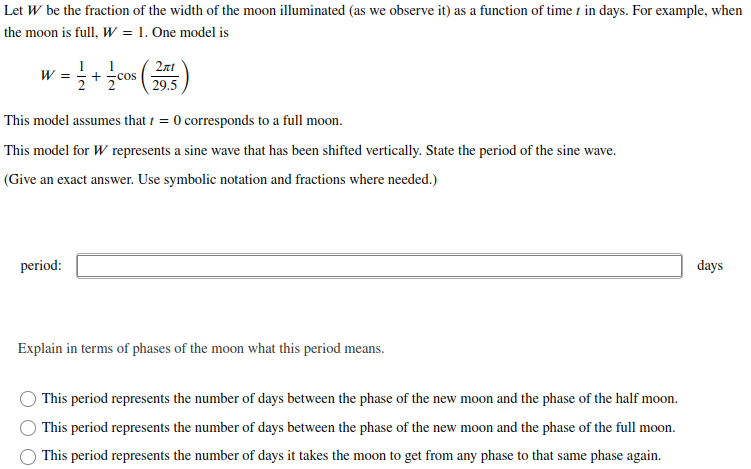Let W be the fraction of the width of the moon illuminated (as we observe it) as a function of time i in days. For example, when the moon is full, W = 1. One model is 1 2at cos 29.5 This model assumes that 1 = 0 corresponds to a full moon. This model for W represents a sine wave that has been shifted vertically. State the period of the sine wave. (Give an exact answer. Use symbolic notation and fractions where needed.) period: days Explain in terms of phases of the moon what this period means. This period represents the number of days between the phase of the new moon and the phase of the half moon. This period represents the number of days between the phase of the new moon and the phase of the full moon. This period represents the number of days it takes the moon to get from any phase to that same phase again.
Let W be the fraction of the width of the moon illuminated (as we observe it) as a function of time i in days. For example, when the moon is full, W = 1. One model is 1 2at cos 29.5 This model assumes that 1 = 0 corresponds to a full moon. This model for W represents a sine wave that has been shifted vertically. State the period of the sine wave. (Give an exact answer. Use symbolic notation and fractions where needed.) period: days Explain in terms of phases of the moon what this period means. This period represents the number of days between the phase of the new moon and the phase of the half moon. This period represents the number of days between the phase of the new moon and the phase of the full moon. This period represents the number of days it takes the moon to get from any phase to that same phase again.
Algebra & Trigonometry with Analytic Geometry
13th Edition
ISBN:9781133382119
Author:Swokowski
Publisher:Swokowski
Chapter7: Analytic Trigonometry
Section7.3: The Addition And Subtraction Formulas
Problem 70E
Related questions
Question
You don't need to answer the multiple-choice question.

Transcribed Image Text:Use the model for W to determine how much of the width of the moon is illuminated 8 days after a full moon.
(Give your answer to the nearest whole number.)
W =
The following observation is taken from the website of the Astronomical Applications Department of the U.S.
Naval Observatory:
Although Full Moon occurs each month at a specific date and time, the Moon's disk may appear to be full for several nights in a
row if it is clear. This is because the percentage of the Moon's disk that appears illuminated changes very slowly around the time
of Full Moon (also around New Moon, but the Moon is not visible at all then).
Explain this observation in terms of a graph of the function W and rates of change. Use the graphing utility to plot the graph
of W.

Transcribed Image Text:Let W be the fraction of the width of the moon illuminated (as we observe it) as a function of time i in days. For example, when
the moon is full, W = 1. One model is
1
2xt
W =
+
-cos
29.5
This model assumes that i = 0 corresponds to a full moon.
This model for W represents a sine wave that has been shifted vertically. State the period of the sine wave.
(Give an exact answer. Use symbolic notation and fractions where needed.)
period:
days
Explain in terms of phases of the moon what this period means.
This period represents the number of days between the phase of the new moon and the phase of the half moon.
This period represents the number of days between the phase of the new moon and the phase of the full moon.
This period represents the number of days it takes the moon to get from any phase to that same phase again.
Expert Solution
This question has been solved!
Explore an expertly crafted, step-by-step solution for a thorough understanding of key concepts.
This is a popular solution!
Trending now
This is a popular solution!
Step by step
Solved in 3 steps with 1 images

Recommended textbooks for you

Algebra & Trigonometry with Analytic Geometry
Algebra
ISBN:
9781133382119
Author:
Swokowski
Publisher:
Cengage

Trigonometry (MindTap Course List)
Trigonometry
ISBN:
9781337278461
Author:
Ron Larson
Publisher:
Cengage Learning

Trigonometry (MindTap Course List)
Trigonometry
ISBN:
9781305652224
Author:
Charles P. McKeague, Mark D. Turner
Publisher:
Cengage Learning

Algebra & Trigonometry with Analytic Geometry
Algebra
ISBN:
9781133382119
Author:
Swokowski
Publisher:
Cengage

Trigonometry (MindTap Course List)
Trigonometry
ISBN:
9781337278461
Author:
Ron Larson
Publisher:
Cengage Learning

Trigonometry (MindTap Course List)
Trigonometry
ISBN:
9781305652224
Author:
Charles P. McKeague, Mark D. Turner
Publisher:
Cengage Learning